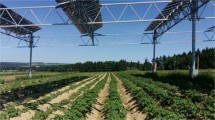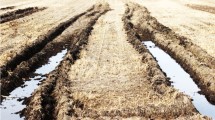Abstract
The application of electricity to plant cultivation has a long and contentious history. Plants are exposed to natural electric fields throughout their life cycles. Therefore, electric fields should be considered as an environmental factor that affects plant growth and development. Here, we provide a review of the literature on the responses of several plants to various electric field treatments. We summarize plant responses to electric fields and discuss current challenges and future opportunities in electro-culture.
Similar content being viewed by others
References
An JI, Lee SR, Oh MM (2021) Air anions promote the growth and mineral accumulation of spinach (Spinacia oleracea) cultivated in greenhouses. Hortic Sci Technol 39:332–342
Anon (1892) Actinism. The Electrician 29:110
Bennett AJ, Harrison RG (2007) Atmospheric electricity in different weather conditions. Weather 62:277–283
Black JD, Forsyth FR, Fensom DS, Ross RB (1971) Electrical stimulation and its effects on growth and ion accumulation in tomato plants. Can J Botany 49:1809–1815
Blackman VH (1924) Field experiments in electro-culture. J Agric Sci 14:240–267
Blackman VH, Legg AT (1924) Pot-culture experiments with an electric discharge. J Agric Sci 14:268–286
Briggs LJ, Campbell AB, Heald RH, Flint LH (1926) Electroculture. US Dept Agric, Washington D.C.
Burdon-Sanderson J (1873) I. note on the electrical phenomena which accompany irritation of the leaf of Dionaea muscipula. Proc Royal Soc Lond 21:495–496
Chand PK, Ochatt SJ, Rech EL, Power JB, Davey MR (1988) Electroporation stimulates plant regeneration from protoplasts of the woody medicinal species Solarium dulcamara L. J Exp Bot 39:1267–1274
Cogalniceanu G, Radu M, Fologea D, Moisoi N, Brezeanu A (1998) Stimulation of tobacco shoot regeneration by alternating weak electric field. Bioelectrochem Bioenerg 44:257–260
Collins GN, Flint LH, McLane JW (1929) Electric stimulation of plant growth. J Agric Res 38:585–600
Dannehl D (2018) Effects of electricity on plant responses. Sci Hortic 234:382–392
Dannehl D, Huyskens-Keil S, Eichholz I, Ulrichs C, Schmidt U (2009) Effects of intermittent-direct-electric-current (IDC) on polyphenols and antioxidant activity in radish (Raphanus sativus L.) during growth. J Appl Bot-Angew Bot 83:54–59
Dijak M, Smith DL, Wilson TJ, Brown DCW (1986) Stimulation of direct embryogenesis from mesophyll protoplasts of Medicago sativa. Plant Cell Rep 5:468–470
Elkiey TM, Bhartendu S, Barthakur N (1985) Air ion effect on respiration and photosynthesis of barley and Antirrhinum majus. Int J Biometeorol 29:285–292
Fromm J, Lautner S (2006) Characteristics and functions of phloem-transmitted electrical signals in higher plants. In: Baluska F, Mancuso S, Volkmann D (eds) Communication in plants – neuronal aspects of Plant Life. Springer-Verlag, Berlin and Heidelberg, pp 321–332. In
Fromm J, Lautner S (2007) Electrical signals and their physiological significance in plants: electrical signals in plants. Plant Cell Environ 30:249–257
Goldsworthy A, Rathore KS (1985) The electrical control of growth in plant tissue cultures: the polar transport of auxin. J Exp Bot 36:1134–1141
Guderjan M, Topfl S, Angersbach A, Knorr D (2005) Impact of pulsed electric field treatment on the recovery and quality of plant oils. J Food Eng 67:281–287
Hull GS (1898) Electro-horticulture. The Knickerbocker Press, New York
Iimoto M, Watanabe K, Fujiwara K (1996) Effects of magnetic flux density and direction of the magnetic field on growth and CO2 exchange rate of potato plantlets in vitro. Acta Hortic 440:606–610
Jones DB, Bolwell GP, Gilliatt GJ (1986) Amplification, by pulsed electromagnetic fields, of plant growth regulator induced phenylalanine ammonia-lyase during differentiation in suspension cultured plant cells. J Bioelectr 5:1–12
Kaimoyo E, Farag MA, Sumner LW, Wasmann C, Cuello JL, VanEtten H (2008) Sub-lethal levels of electric current elicit the biosynthesis of plant secondary metabolites. Biotechnol Prog 24:377–384
Kalinina IM, Krstić V, Tolić-Nørrelykke IM (2010) Cell polarity: which way to grow in an electric field? Curr Biol 20:R355–R356
Kim HN, Yi PH, Park JH (2022) Evaluation of plant-induced electrical signal and growth of broccoli (Brassica oleracea var. italica) in response to urea application in soil. Hortic Sci Technol 40:210–218
Kotaka S, Krueger AP (1978) Effects of air ions on microorganisms and other biological materials. Crit Rev Microbiol 6:109–149
Kotaka S, Krueger AP, Andriese PC, Nishizawa K, Ohuchi T, Takenobu M, Kozure Y (1965) Air ion effects on the oxygen consumption of barley seedlings. Nature 208:1112–1113
Krueger AP, Kotaka S, Andriese PC (1962) Studies on the effects of gaseous ions on plant growth. I. The influence of positive and negative air ions on the growth of Avena sativa. J Gen Physiol 45:879–895
Lanzerotti L, Gregori G (1986) Telluric currents: the natural environment and interactions with man-made systems. The Earth’s Electrical Environment. National Academies Press, Washington D.C.
Lautner S, Grams TEE, Matyssek R, Fromm J (2005) Characteristics of electrical signals in poplar and responses in photosynthesis. Plant Physiol 138:2200–2209
Lee SR, Oh MM (2021) Electric stimulation promotes growth, mineral uptake, and antioxidant accumulation in kale (Brassica oleracea var. acephala). Bioelectrochemistry 138:107727
Lee SR, Kang TH, Han CS, Oh MM (2015) Air anions improve growth and mineral content of kale in plant factories. Hortic Environ Biotechnol 56:462–471
Lee SR, Song MJ, Oh MM (2022) Effects of air anions on growth and economic feasibility of lettuce: a plant factory experiment approach. Sustainability 14:15468
Lemström S (1904) Electricity in agriculture and horticulture. The Electrician Printing & Publishing, London
Leong SY, Burritt DJ, Oey I (2016) Electropriming of wheatgrass seeds using pulsed electric fields enhances antioxidant metabolism and the bioprotective capacity of wheatgrass shoots. Sci Rep 6:1–13
Maruvada PS (2012) Electric field and ion current environment of HVDC transmission lines: comparison of calculations and measurements. IEEE Trans Power Deliv 27:401–410
McDonald JE (1953) The earth’s electricity. Sci Am 188:32–37
Melikov KC, Frolov VA, Shcherbakov A, Samsonov AV, Chizmadzhev YA, Chernomordik LV (2001) Voltage-induced nonconductive pre-pores and metastable single pores in unmodified planar lipid bilayer. Biophys J 80:1829–1836
Moon JD, Chung HS (2000) Acceleration of germination of tomato seed by applying AC electric and magnetic fields. J Electrostat 48:103–114
Murr LE (1963) Plant growth response in a simulated electric field environment. Nature 200:490–491
Murr LE (1964) Mechanism of plant-cell damage in an electrostatic field. Nature 201:1305–1306
Murr LE (1965) Biophysics of plant growth in an electrostatic field. Nature 206:467–470
Murr LE (1966) Physiological stimulation of plants using delayed and regulated electric field environments. Int J Biometeor 10:147–153
Neumann E, Rosenheck K (1972) Permeability changes induced by electric impulses in vesicular membranes. J Membr Biol 10:279–290
Ochatt SJ, Chand PK, Rech EL, Davey MR, Power JB (1988) Electroporation-mediated improvement of plant regeneration from colt cherry (Prunus avium × pseudocerasus) protoplasts. Plant Sci 54:165–169
Ozuna C, Cerón-García A, Sosa-Morales ME, Gómez Salazar JA, León-Galván MF, Abraham-Juárez MR (2018) Electrically induced changes in amaranth seed enzymatic activity and their effect on bioactive compounds content after germination. J Food Sci Technol 55:648–657
Pavlovič A (2012) The effect of electrical signals on photosynthesis and respiration. In: Volkov AG (ed) Plant electrophysiology – signaling and responses. Springer-Verlag, Berlin and Heidelberg, In
Pohl HA (1977) Electroculture. J Biol Phys 5:3–23
Rathore KS, Goldsworthy A (1985) Electrical control of shoot regeneration in plant tissue cultures. Nat Biotechnol 3:1107–1109
Rech EL, Ochatt SJ, Chand PK, Power JB, Davey MR (1987) Electro-enhancement of division of plant protoplast-derived cells. Protoplasma 141:169–176
Schmiedchen K, Petri AK, Driessen S, Bailey WH (2018) Systematic review of biological effects of exposure to static electric fields. Part II: invertebrates and plants. Environ Res 160:60–76
Scott BIH (1967) Electric fields in plants. Annu Rev Plant Physiol 18:409–418
Shine MB, Guruprasad KN, Anand A (2011) Enhancement of germination, growth, and photosynthesis in soybean by pre-treatment of seeds with magnetic field. Bioelectromagnetics 32:474–484
Sibaoka T (1969) Physiology of rapid movements in higher plants. Annu Rev Plant Physiol 20:165–184
Soliva-Fortuny R, Balasa A, Knorr D, Martín-Belloso O (2009) Effects of pulsed electric fields on bioactive compounds in foods: a review. Trends Food Sci Technol 20:544–556
Solly E (1846) Report on the Fifteenth Meeting of the british Society for the Advancement of Science. British Association for the Advancement of Science, London
Song MJ, Kang TH, Han CS, Oh MM (2014) Air anions enhance lettuce growth in plant factories. Hortic Environ Biotechnol 55:293–298
Stone GE (1911) Cyclopedia of American Agriculture. Vol 2: crops. Macmillan, London
Sukhov V, Sukhova E, Vodeneev V (2019) Long-distance electrical signals as a link between the local action of stressors and the systemic physiological responses in higher plants. Prog Biophys Mol Biol 146:63–84
Vallverdú-Queralt A, Oms-Oliu G, Odriozola-Serrano I, Lamuela-Raventos RM, Martin-Belloso O, Elez-Martinez P (2012) Effects of pulsed electric fields on the bioactive compound content and antioxidant capacity of tomato fruit. J Agric Food Chem 60:3126–3134
Volkov AG (2006) Plant electrophysiology – theory and methods. Springer-Verlag, Berlin and Heidelberg
Volkov AG, Markin VS (2015) Active and Passive Electrical signaling in plants. Prog Bot 76:143–176
Volkov AG, Shtessel YB (2018) Electrical signal propagation within and between tomato plants. Bioelectrochemistry 124:195–205
Wanner LA, Li G, Ware D, Somssich IE, Davis KR (1995) The phenylalanine ammonia-lyase gene family in Arabidopsis thaliana. Plant Mol Biol 27:327–338
Wechsler D (2015) Electro-Horticulture. Leanpub, British Columbia
Ye H, Huang LL, Chen SD, Zhong JJ (2004) Pulsed electric field stimulates plant secondary metabolism in suspension cultures of Taxus chinensis. Biotechnol Bioeng 88:788–795
Zhang H, Hashinaga F (1997) Effect of high electric fields on the germination and early growth of some vegetable seeds. J Japanese Soc Hort Sci 66:347–352
Zimmermann MR, Maischak H, Mithöfer A, Boland W, Felle HH (2009) System potentials, a novel electrical long-distance apoplastic signal in plants, induced by wounding. Plant Physiol 149:1593–1600
Acknowledgements
This research was supported by the Basic Science Research Program through the National Research Foundation of Korea (NRF) funded by the Ministry of Education (grant number 2020R1I1A3074865).
Author information
Authors and Affiliations
Contributions
Conceptualization, writing—original draft preparation, and project administration, S.R. Lee; writing—review and funding acquisition, M.M. Oh. All authors have read and agreed to the published version of the manuscript.
Corresponding author
Ethics declarations
Conflict of interest
The authors declare that they have no known competing financial interests or personal relationships that could have appeared to influence the work reported in this paper.
Additional information
Communicated by Young Yeol Cho.
Publisher’s Note
Springer Nature remains neutral with regard to jurisdictional claims in published maps and institutional affiliations.
Rights and permissions
Springer Nature or its licensor (e.g. a society or other partner) holds exclusive rights to this article under a publishing agreement with the author(s) or other rightsholder(s); author self-archiving of the accepted manuscript version of this article is solely governed by the terms of such publishing agreement and applicable law.
About this article
Cite this article
Lee, S., Oh, MM. Electric field: a new environmental factor for controlling plant growth and development in agriculture. Hortic. Environ. Biotechnol. 64, 955–961 (2023). https://doi.org/10.1007/s13580-023-00525-y
Received:
Revised:
Accepted:
Published:
Issue Date:
DOI: https://doi.org/10.1007/s13580-023-00525-y




